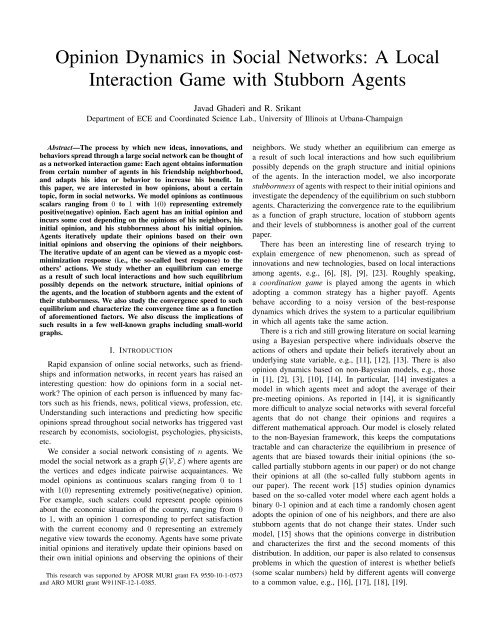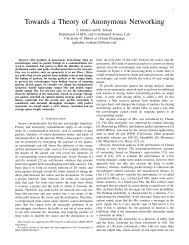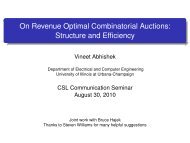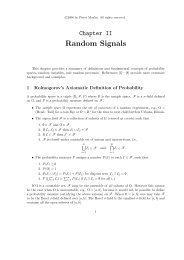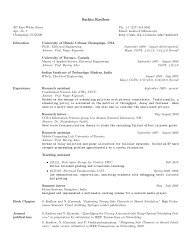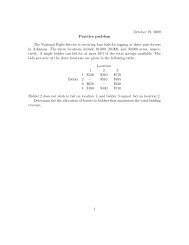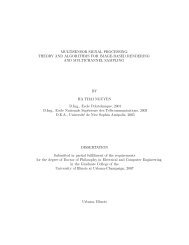Opinion Dynamics in Social Networks: A Local Interaction Game ...
Opinion Dynamics in Social Networks: A Local Interaction Game ...
Opinion Dynamics in Social Networks: A Local Interaction Game ...
You also want an ePaper? Increase the reach of your titles
YUMPU automatically turns print PDFs into web optimized ePapers that Google loves.
<strong>Op<strong>in</strong>ion</strong> <strong>Dynamics</strong> <strong>in</strong> <strong>Social</strong> <strong>Networks</strong>: A <strong>Local</strong><br />
<strong>Interaction</strong> <strong>Game</strong> with Stubborn Agents<br />
Javad Ghaderi and R. Srikant<br />
Department of ECE and Coord<strong>in</strong>ated Science Lab., University of Ill<strong>in</strong>ois at Urbana-Champaign<br />
Abstract—The process by which new ideas, <strong>in</strong>novations, and<br />
behaviors spread through a large social network can be thought of<br />
as a networked <strong>in</strong>teraction game: Each agent obta<strong>in</strong>s <strong>in</strong>formation<br />
from certa<strong>in</strong> number of agents <strong>in</strong> his friendship neighborhood,<br />
and adapts his idea or behavior to <strong>in</strong>crease his benefit. In<br />
this paper, we are <strong>in</strong>terested <strong>in</strong> how op<strong>in</strong>ions, about a certa<strong>in</strong><br />
topic, form <strong>in</strong> social networks. We model op<strong>in</strong>ions as cont<strong>in</strong>uous<br />
scalars rang<strong>in</strong>g from 0 to 1 with 1(0) represent<strong>in</strong>g extremely<br />
positive(negative) op<strong>in</strong>ion. Each agent has an <strong>in</strong>itial op<strong>in</strong>ion and<br />
<strong>in</strong>curs some cost depend<strong>in</strong>g on the op<strong>in</strong>ions of his neighbors, his<br />
<strong>in</strong>itial op<strong>in</strong>ion, and his stubbornness about his <strong>in</strong>itial op<strong>in</strong>ion.<br />
Agents iteratively update their op<strong>in</strong>ions based on their own<br />
<strong>in</strong>itial op<strong>in</strong>ions and observ<strong>in</strong>g the op<strong>in</strong>ions of their neighbors.<br />
The iterative update of an agent can be viewed as a myopic costm<strong>in</strong>imization<br />
response (i.e., the so-called best response) to the<br />
others’ actions. We study whether an equilibrium can emerge<br />
as a result of such local <strong>in</strong>teractions and how such equilibrium<br />
possibly depends on the network structure, <strong>in</strong>itial op<strong>in</strong>ions of<br />
the agents, and the location of stubborn agents and the extent of<br />
their stubbornness. We also study the convergence speed to such<br />
equilibrium and characterize the convergence time as a function<br />
of aforementioned factors. We also discuss the implications of<br />
such results <strong>in</strong> a few well-known graphs <strong>in</strong>clud<strong>in</strong>g small-world<br />
graphs.<br />
I. INTRODUCTION<br />
Rapid expansion of onl<strong>in</strong>e social networks, such as friendships<br />
and <strong>in</strong>formation networks, <strong>in</strong> recent years has raised an<br />
<strong>in</strong>terest<strong>in</strong>g question: how do op<strong>in</strong>ions form <strong>in</strong> a social network?<br />
The op<strong>in</strong>ion of each person is <strong>in</strong>fluenced by many factors<br />
such as his friends, news, political views, profession, etc.<br />
Understand<strong>in</strong>g such <strong>in</strong>teractions and predict<strong>in</strong>g how specific<br />
op<strong>in</strong>ions spread throughout social networks has triggered vast<br />
research by economists, sociologist, psychologies, physicists,<br />
etc.<br />
We consider a social network consist<strong>in</strong>g of n agents. We<br />
model the social network as a graph G(V, E) where agents are<br />
the vertices and edges <strong>in</strong>dicate pairwise acqua<strong>in</strong>tances. We<br />
model op<strong>in</strong>ions as cont<strong>in</strong>uous scalars rang<strong>in</strong>g from 0 to 1<br />
with 1(0) represent<strong>in</strong>g extremely positive(negative) op<strong>in</strong>ion.<br />
For example, such scalers could represent people op<strong>in</strong>ions<br />
about the economic situation of the country, rang<strong>in</strong>g from 0<br />
to 1, with an op<strong>in</strong>ion 1 correspond<strong>in</strong>g to perfect satisfaction<br />
with the current economy and 0 represent<strong>in</strong>g an extremely<br />
negative view towards the economy. Agents have some private<br />
<strong>in</strong>itial op<strong>in</strong>ions and iteratively update their op<strong>in</strong>ions based on<br />
their own <strong>in</strong>itial op<strong>in</strong>ions and observ<strong>in</strong>g the op<strong>in</strong>ions of their<br />
This research was supported by AFOSR MURI grant FA 9550-10-1-0573<br />
and ARO MURI grant W911NF-12-1-0385.<br />
neighbors. We study whether an equilibrium can emerge as<br />
a result of such local <strong>in</strong>teractions and how such equilibrium<br />
possibly depends on the graph structure and <strong>in</strong>itial op<strong>in</strong>ions<br />
of the agents. In the <strong>in</strong>teraction model, we also <strong>in</strong>corporate<br />
stubbornness of agents with respect to their <strong>in</strong>itial op<strong>in</strong>ions and<br />
<strong>in</strong>vestigate the dependency of the equilibrium on such stubborn<br />
agents. Characteriz<strong>in</strong>g the convergence rate to the equilibrium<br />
as a function of graph structure, location of stubborn agents<br />
and their levels of stubbornness is another goal of the current<br />
paper.<br />
There has been an <strong>in</strong>terest<strong>in</strong>g l<strong>in</strong>e of research try<strong>in</strong>g to<br />
expla<strong>in</strong> emergence of new phenomenon, such as spread of<br />
<strong>in</strong>novations and new technologies, based on local <strong>in</strong>teractions<br />
among agents, e.g., [6], [8], [9], [23]. Roughly speak<strong>in</strong>g,<br />
a coord<strong>in</strong>ation game is played among the agents <strong>in</strong> which<br />
adopt<strong>in</strong>g a common strategy has a higher payoff. Agents<br />
behave accord<strong>in</strong>g to a noisy version of the best-response<br />
dynamics which drives the system to a particular equilibrium<br />
<strong>in</strong> which all agents take the same action.<br />
There is a rich and still grow<strong>in</strong>g literature on social learn<strong>in</strong>g<br />
us<strong>in</strong>g a Bayesian perspective where <strong>in</strong>dividuals observe the<br />
actions of others and update their beliefs iteratively about an<br />
underly<strong>in</strong>g state variable, e.g., [11], [12], [13]. There is also<br />
op<strong>in</strong>ion dynamics based on non-Bayesian models, e.g., those<br />
<strong>in</strong> [1], [2], [3], [10], [14]. In particular, [14] <strong>in</strong>vestigates a<br />
model <strong>in</strong> which agents meet and adopt the average of their<br />
pre-meet<strong>in</strong>g op<strong>in</strong>ions. As reported <strong>in</strong> [14], it is significantly<br />
more difficult to analyze social networks with several forceful<br />
agents that do not change their op<strong>in</strong>ions and requires a<br />
different mathematical approach. Our model is closely related<br />
to the non-Bayesian framework, this keeps the computations<br />
tractable and can characterize the equilibrium <strong>in</strong> presence of<br />
agents that are biased towards their <strong>in</strong>itial op<strong>in</strong>ions (the socalled<br />
partially stubborn agents <strong>in</strong> our paper) or do not change<br />
their op<strong>in</strong>ions at all (the so-called fully stubborn agents <strong>in</strong><br />
our paper). The recent work [15] studies op<strong>in</strong>ion dynamics<br />
based on the so-called voter model where each agent holds a<br />
b<strong>in</strong>ary 0-1 op<strong>in</strong>ion and at each time a randomly chosen agent<br />
adopts the op<strong>in</strong>ion of one of his neighbors, and there are also<br />
stubborn agents that do not change their states. Under such<br />
model, [15] shows that the op<strong>in</strong>ions converge <strong>in</strong> distribution<br />
and characterizes the first and the second moments of this<br />
distribution. In addition, our paper is also related to consensus<br />
problems <strong>in</strong> which the question of <strong>in</strong>terest is whether beliefs<br />
(some scalar numbers) held by different agents will converge<br />
to a common value, e.g., [16], [17], [18], [19].
We use the follow<strong>in</strong>g basic notations. x T denotes the<br />
transpose of vector x. Given two functions f and g, f = O(g)<br />
if sup n |f(n)/g(n)| < ∞. f = Ω(g) if g = O(f). If both<br />
f = O(g) and f = Ω(g), then f = Θ(g).<br />
Due to page constra<strong>in</strong>ts, we have to omit proofs of the<br />
results and some of the details but they are provided <strong>in</strong> the<br />
complete version of the paper [31].<br />
II. MODEL AND DEFINITIONS<br />
Consider a social network with n agents, denoted by a graph<br />
G(V, E) where agents are the vertices and edges <strong>in</strong>dicate the<br />
pairs of agents that have <strong>in</strong>teractions. For each agent i, def<strong>in</strong>e<br />
its neighborhood ∂ i as the set of agents that node i <strong>in</strong>teracts<br />
with, i.e., ∂ i := {j : (i, j) ∈ E}. Each agent i has an <strong>in</strong>itial<br />
op<strong>in</strong>ion x i (0) ∈ [0, 1]. Let x(0) := [x 1 (0) · · · x n (0)] T denote<br />
the vector of <strong>in</strong>itial op<strong>in</strong>ions. We assume each agent i has a<br />
cost function of the form<br />
J i (x i , x ∂i ) = 1 ∑<br />
(x i − x j ) 2 + 1 2<br />
2 K i(x i − x i (0)) 2 , (1)<br />
j∈∂ i<br />
that he tries to m<strong>in</strong>imize where K i ≥ 0 measures the stubbornness<br />
of agent i regard<strong>in</strong>g his <strong>in</strong>itial op<strong>in</strong>ion 1 . When none of<br />
the agents are stubborn, correspond<strong>in</strong>gly K i ’s are all zero, the<br />
above formulation def<strong>in</strong>es a coord<strong>in</strong>ation game with cont<strong>in</strong>uous<br />
payoffs because any vector of op<strong>in</strong>ions x = [x 1 · · · x n ] T<br />
with x 1 = x 2 = · · · = x n is a Nash equilibrium. Here,<br />
we consider a synchronous version of the game between the<br />
agents. At each time, every agent observes the op<strong>in</strong>ions of his<br />
neighbors and updates his op<strong>in</strong>ion based on these observations<br />
and also his own <strong>in</strong>itial op<strong>in</strong>ion <strong>in</strong> order to m<strong>in</strong>imize his cost<br />
function. It is easy to check that, for every agent i, the bestresponse<br />
strategy is<br />
x i (t + 1) =<br />
1 ∑<br />
d i + K i<br />
j∈∂ i<br />
x j (t) +<br />
K i<br />
d i + K i<br />
x i (0), (2)<br />
where d i = |∂ i | is the degree of node i <strong>in</strong> graph G. Def<strong>in</strong>e a<br />
matrix A n×n such that A ij = 1<br />
d i+K i<br />
for (i, j) ∈ E and zero<br />
otherwise. Also def<strong>in</strong>e a diagonal matrix B n×n with B ii =<br />
K i<br />
d i+K i<br />
for 1 ≤ i ≤ n. Thus, <strong>in</strong> the matrix form, the bestresponse<br />
dynamics are given by<br />
x(t + 1) = Ax(t) + Bx(0). (3)<br />
Iterat<strong>in</strong>g (3) shows that the vector of op<strong>in</strong>ions at each time<br />
t ≥ 0 is<br />
∑t−1<br />
x(t) = A t x(0) + A s Bx(0). (4)<br />
s=0<br />
In the rest of the paper, we <strong>in</strong>vestigate the existence of<br />
equilibrium, x(∞) := lim t→∞ x(t), under the dynamics (3)<br />
<strong>in</strong> different social networks, with or without stubborn agents.<br />
We also characterize the convergence time of the dynamics,<br />
i.e., the amount of time that it takes for the agents’ op<strong>in</strong>ions<br />
1 Although we have considered uniform weights for the neighbors, the<br />
results <strong>in</strong> the paper hold under a more general sett<strong>in</strong>g when each agent puts<br />
a weight w ij for his neighbor j.<br />
to get close to the equilibrium. The equilibrium behavior is<br />
relevant only if the convergence time is reasonable [9].<br />
Without loss of generality, assume that G is a connected<br />
graph (otherwise, we can consider op<strong>in</strong>ion dynamics separately<br />
over each connected subgraph).<br />
III. NO STUBBORN AGENTS<br />
Convergence issues <strong>in</strong> the case of no stubborn agents is a<br />
special case of consensus, and has been well studied. Here,<br />
we briefly review this work to put our later results <strong>in</strong> context.<br />
When there are no stubborn agents, A can be viewed as<br />
a transition probability matrix of a random walk over G (see<br />
[31] for all details). Then, it is not difficult to show that, <strong>in</strong><br />
non-bipartite social graphs, the best-response dynamics will<br />
converge to the follow<strong>in</strong>g unique equilibrium<br />
x i (∞) = 1<br />
2|E|<br />
n∑<br />
d j x j (0); for all i ∈ V, (5)<br />
j=1<br />
i.e., agents will reach a consensus <strong>in</strong> equilibrium where the<br />
impact of each agent on the equilibrium consensus is directly<br />
proportional to its degree. Also it can be shown that the<br />
error, e(t) := x(t) − x(∞), goes to zero geometrically, <strong>in</strong><br />
some appropriate norm, at a rate equal to the second largest<br />
eigenvalue modulus of A. In the case that the social graph is<br />
bipartite, e.g., a r<strong>in</strong>g graph with an even number of agents<br />
n, the best-response dynamics might not converge to an<br />
equilibrium. In practice, not everyone completely ignores his<br />
own previous op<strong>in</strong>ion and might be slightly biased by his old<br />
op<strong>in</strong>ion. Hence, we can consider a noisy version of the bestresponse<br />
dynamics as follows<br />
(<br />
x (ɛ)<br />
1 ∑ )<br />
i (t + 1) = (1 − ɛ)<br />
+ ɛx i (t), (6)<br />
d i<br />
j∈∂ i<br />
x j (t)<br />
for some self-confidence ɛ > 0 2 . Then, it can be shown that<br />
the noisy best-response dynamics, <strong>in</strong> bipartite or non-bipartite<br />
social graphs, will converge to the equilibrium (5) ( <strong>in</strong>depen-<br />
)<br />
dently of ɛ. Moreover, the convergence time is Θ<br />
1<br />
1−λ 2(A)<br />
as n grows, where λ 2 (A) is the second largest eigenvalue of<br />
A.<br />
Example 1. In this example, we make a comparison between<br />
two extreme <strong>in</strong>teraction scenarios, namely, r<strong>in</strong>g graph and<br />
complete graph with n nodes. The complete graph represents<br />
situation when all agents can communicate with each other<br />
with no constra<strong>in</strong>s, while <strong>in</strong> the r<strong>in</strong>g graph, each agent can<br />
only communicate with his two nearest neighbors. In both<br />
cases the (noisy) best-response dynamics converge to the<br />
average of <strong>in</strong>itial op<strong>in</strong>ions. It is easy to see that λ 2 (A) is<br />
1<br />
n−1 for the complete graph and cos( 2π n ) ≈ 1 − π n 2 for<br />
the r<strong>in</strong>g. Hence, while both of the graphs have the same<br />
equilibrium, convergence <strong>in</strong> the complete graph is much faster<br />
than convergence <strong>in</strong> the r<strong>in</strong>g, <strong>in</strong> fact, O(1) vs. O(n 2 ).<br />
2 Here, we assume all agents have the same self-confidence but the argument<br />
can be adapted for different self-confidences as well.<br />
,
There is a rich literature on approximat<strong>in</strong>g λ 2 (A) of the<br />
random walk A over different types of graphs, e.g., see<br />
Chapter 2 of [5] for a survey. Intuitively, the convergence<br />
time is deteriorated by the highly connected component of<br />
the graph which is loosely connected to the rest of the<br />
network (captured by the notion of conductance, or the edge<br />
isoperimetric function of the graph). Thus, we do not proceed<br />
<strong>in</strong> this direction further and <strong>in</strong> the next section, we study the<br />
more <strong>in</strong>terest<strong>in</strong>g case of social networks with stubborn agents.<br />
IV. IMPACT OF STUBBORN AGENTS<br />
A. Existence and characterization of equilibrium<br />
Consider a connected social network G(V, E) <strong>in</strong> which at<br />
least one of the agents is stubborn, i.e., K i > 0 for at least<br />
one i ∈ V. Then A is an irreducible sub-stochastic matrix<br />
with the row-sum of at least one row less than one. Let<br />
ρ 1 (A) := max i |λ i (A)| denote the spectral radius of A. It<br />
is well-known that ρ 1 (A) of a sub-stochastic matrix A is less<br />
than one, and hence, lim t→∞ A t = 0. Therefore, by Perron-<br />
Ferobenius theorem, the largest eigenvalue should be positive,<br />
real 1 > λ 1 > 0 and ρ 1 (A) = λ 1 . Hence, <strong>in</strong> this case, based<br />
on (4), the equilibrium exists and is equal to<br />
x(∞) := lim<br />
t→∞<br />
x(t) =<br />
∞∑<br />
A s Bx(0) = (I − A) −1 Bx(0). (7)<br />
s=0<br />
Therefore, s<strong>in</strong>ce B ii = 0 for all non-stubborn agents i, the<br />
<strong>in</strong>itial op<strong>in</strong>ions of non-stubborn agents will vanish eventually<br />
and have no effect on the equilibrium (7).<br />
The matrix form (7) does not give any <strong>in</strong>sight on how the<br />
equilibrium depends on the graph structure and the stubborn<br />
agents. Next, we describe the equilibrium <strong>in</strong> terms of explicit<br />
quantities that depend on the graph structure, location of<br />
stubborn agents and their levels of stubbornness.<br />
Let S ⊆ V be the set of stubborn agents and |S| ≥ 1. Any<br />
agent i <strong>in</strong> S is either fully stubborn, mean<strong>in</strong>g its correspond<strong>in</strong>g<br />
K i = ∞, or it is partially stubborn, mean<strong>in</strong>g 0 < K i < ∞.<br />
Hence, S = S F ∪ S P where S F is the set of fully stubborn<br />
agents and S P is the set of partially stubborn agents. Next,<br />
we construct a weighted graph Ĝ( ˆV, Ê) as follows. Assign<br />
weight 1 to all the edges of G. Connect a new vertex u i to<br />
each i ∈ S P and assign a weight K i to the correspond<strong>in</strong>g<br />
edge. Let ˆV := V ∪ {u i : i ∈ S P } and Ê := E ∪ {(i, u i) :<br />
i ∈ S P }. Also let w ij denote the weight of edge (i, j) ∈ Ê.<br />
Then Ĝ( ˆV, Ê) is a weighted graph with weights w ij = 1 for<br />
all (i, j) ∈ E (the edges of G) and w iui = K i for all i ∈ S P .<br />
Let u(S P ) = {u i : i ∈ S P }. Def<strong>in</strong>e w i := ∑ j:(i,j)∈Ê w ij as<br />
the weighted degree of vertex i ∈ ˆV. It should be clear that<br />
⎧<br />
⎨ d i + K i for i ∈ S P ,<br />
w i = d i for i ∈ V\S P ,<br />
(8)<br />
⎩<br />
K j for i = u j , j ∈ S P .<br />
Consider the random walk Y (t) over Ĝ where the probability<br />
of transition from vertex i to vertex j is P ij = wij<br />
w i<br />
. Assume the<br />
walk starts from some <strong>in</strong>itial vertex Y (0) = i ∈ V. For any j ∈<br />
ˆV, def<strong>in</strong>e τ j := <strong>in</strong>f{t ≥ 0 : Y (t) = j}, as the first hitt<strong>in</strong>g time<br />
to vertex j. Also def<strong>in</strong>e τ := ∧ j∈S F ∪u(S P ) τ j as the first time<br />
that the random walk hits any of the vertices <strong>in</strong> S F ∪ u(S P ).<br />
The follow<strong>in</strong>g Lemma characterizes the equilibrium.<br />
Lemma 1. The best-response dynamics converge to a unique<br />
equilibrium where the op<strong>in</strong>ion of each agent is a convex<br />
comb<strong>in</strong>ation of the <strong>in</strong>itial op<strong>in</strong>ions of the stubborn agents.<br />
Based on the random walk over the graph Ĝ,<br />
x i (∞) = ∑<br />
P i (τ = τ uj )x j (0) + ∑<br />
P i (τ = τ j )x j (0), (9)<br />
j∈S P j∈S F<br />
for all 1 ≤ i ≤ n, where P i (τ = τ k ), k ∈ S F ∪ u(S P ), is the<br />
probability that the random walk hits vertex k first, among<br />
vertices <strong>in</strong> S F ∪ u(S P ), given the random walk starts from<br />
vertex i.<br />
Note that lim Ki→∞ P i (τ = τ ui ) = 1 for any partially<br />
stubborn agent i ∈ S P . This <strong>in</strong>tuitively makes sense because<br />
as an agent i becomes more stubborn, his op<strong>in</strong>ion will get<br />
closer to his own op<strong>in</strong>ion and behaves similarly to a fully<br />
stubborn agent. It should be clear that when there is only<br />
one stubborn agent or there are multiple stubborn agents with<br />
identical <strong>in</strong>itial op<strong>in</strong>ions, eventually the op<strong>in</strong>ion of every agent<br />
will converge to the same op<strong>in</strong>ion as the <strong>in</strong>itial op<strong>in</strong>ion of the<br />
stubborn agents.<br />
Alternatively, the equilibrium has an <strong>in</strong>terest<strong>in</strong>g electrical<br />
network <strong>in</strong>terpretation as follows.<br />
Lemma 2. Consider G as an electrical network where the<br />
conductance of each edge is 1 and each stubborn agent i is a<br />
voltage source of x i (0) volts with an <strong>in</strong>ternal conductance<br />
K i . Fully stubborn agents are ideal voltage sources with<br />
<strong>in</strong>f<strong>in</strong>ite <strong>in</strong>ternal conductance (zero <strong>in</strong>ternal resistance). Then,<br />
under the best-response dynamics, the op<strong>in</strong>ion of each agent<br />
at equilibrium is just its voltage <strong>in</strong> the electrical network.<br />
We illustrate the use of the above lemma through the<br />
follow<strong>in</strong>g example.<br />
Example 2. Consider a one-dimensional social graph, where<br />
agents are located on <strong>in</strong>tegers 1 ≤ i ≤ n. Assume nodes 1<br />
and n are stubborn with <strong>in</strong>itial op<strong>in</strong>ions x 1 (0) and x n (0),<br />
and stubbornness parameters K 1 > 0 and K n > 0. Us<strong>in</strong>g the<br />
electrical network model, the current is the same over all edges<br />
and equal to I = (x 1 (0) − x n (0))( 1 K 1<br />
+ 1<br />
K n<br />
+ n − 1) −1 , and<br />
thus the voltage of each node i is v i = x 1 (0) − I( 1 K 1<br />
+ i − 1),<br />
for 1 ≤ i ≤ n. Hence,<br />
where α i :=<br />
x i (∞) = (1 − α i )x 1 (0) + α i x n (0),<br />
B. Convergence time<br />
K −1<br />
1 +i−1 .<br />
K −1<br />
1 +K−1 n +n−1<br />
Let e(t) := x(t) − x(∞) be the error vector. Trivially<br />
e i (t) = 0 for all fully stubborn agents i ∈ S F , so we<br />
focus on ẽ(t) := [e i (t) : i ∈ V\S F ] T . For any real<br />
vector space R m , m > 0, def<strong>in</strong>e a convenient scalar product<br />
〈z, y〉 π := ∑ m<br />
i=1 z iy i π i and its correspond<strong>in</strong>g norm<br />
‖z‖ π<br />
:= (∑ m<br />
i=1 z2 i π i) 1/2<br />
. The follow<strong>in</strong>g lemma states that
convergence to the equilibrium (7) is geometric with a rate<br />
equal to the largest eigenvalue of A.<br />
Lemma 3. Let ˜π = [ wi<br />
Z<br />
: i ∈ V\S F ] T , for w i as <strong>in</strong> (8), and Z<br />
be the normaliz<strong>in</strong>g constant such that ∑ i∈V\S F<br />
˜π i = 1. Then,<br />
‖ẽ(t)‖˜π ≤ (λ A ) t ‖ẽ(0)‖˜π , (10)<br />
where λ A is the largest eigenvalue of A. 3<br />
Def<strong>in</strong><strong>in</strong>g the convergence time as τ(ν) := <strong>in</strong>f{t ≥ 0 :<br />
‖ẽ(t)‖˜π ≤(<br />
ν}, for ) some fixed 0 < ν ≪ 1, shows that<br />
1<br />
τ(ν) = Θ<br />
1−λ A<br />
as n grows. Let T := 1<br />
1−λ A<br />
. With a little<br />
abuse of term<strong>in</strong>ology, we also call T the convergence time.<br />
The exact characterization of λ A <strong>in</strong> social networks with<br />
very large number of users and many stubborn agents is<br />
difficult, hence, we will derive appropriate upper-bounds and<br />
lower-bounds that depend on the graph structure, the location<br />
of stubborn agents and their levels of stubbornness.<br />
Consider the weighted graph Ĝ( ˆV, Ê). A path γ ij from a<br />
vertex i to another vertex j <strong>in</strong> Ĝ is a collection of oriented<br />
edges {(i, i 1 ), (i 1 , i 2 ), · · · , (i m , j)} that connects i to j and<br />
does not <strong>in</strong>tersect itself. For any vertex i ∈ V\S F , consider a<br />
path γ i from i to the set S F ∪ u(S P ), i.e., γ i = γ ij for some<br />
j ∈ S F ∪ u(S P ).<br />
Proceed<strong>in</strong>g along the l<strong>in</strong>es of Diaconis-Stroock [21], we<br />
get the follow<strong>in</strong>g bound that yields an upper-bound on the<br />
convergence time.<br />
Lemma 4. Consider the weighted graph Ĝ. Given a set of<br />
paths {γ i : i ∈ V\S F }, from V\S F to S F ∪ u(S P ), let<br />
|γ i | w := ∑ 1<br />
(s,t)∈γ i w st<br />
. Then, T ≤ 2 max (x,y)∈ Ê<br />
ξ(x, y),<br />
where, for each edge (x, y) ∈ Ê,<br />
ξ(x, y) :=<br />
∑<br />
w i |γ i | w .<br />
i:γ i∋(x,y)<br />
It is also possible to proceed along the l<strong>in</strong>es of S<strong>in</strong>clair [22].<br />
This gives a different bound stated <strong>in</strong> the follow<strong>in</strong>g lemma.<br />
Lemma 5. Consider the weighted graph Ĝ( ˆV, Ê). Given a set<br />
of paths {γ i : i ∈ V\S F } from V\S F to S F ∪ u(S P ), we have<br />
T ≤ 2 max (x,y)∈ Ê<br />
η(x, y), where, for each edge (x, y) ∈ Ê,<br />
η(x, y) := 1 ∑<br />
w i |γ i |.<br />
w xy<br />
i:γ i∋(x,y)<br />
Intuitively, both ξ(x, y) and η(x, y) are measures of congestion<br />
over the edge (x, y) due to paths that pass through (x, y).<br />
See [31] for examples of applications of the above bounds <strong>in</strong><br />
complete and r<strong>in</strong>g graphs and performance comparison with<br />
numerical values.<br />
An upper bound on 1 − λ A , and thus a lower-bound on the<br />
convergence time T , is given by the follow<strong>in</strong>g lemma.<br />
Lemma 6. Consider the weighted graph Ĝ( ˆV, Ê), then<br />
1 − λ A ≤ m<strong>in</strong> ψ(U; Ĝ), (11)<br />
U⊆V\S F<br />
3 In Euclidian norm, ‖e(t)‖ 2 ≤ (λ A ) t√ w max<br />
w m<strong>in</strong><br />
‖e(0)‖ 2 , where w max :=<br />
max i∈V\SF w i and w m<strong>in</strong> := m<strong>in</strong> i∈V\SF w i .<br />
where ψ(U; Ĝ) := ∑<br />
i∈U,j /∈U wij<br />
∑i∈U wi . The m<strong>in</strong>imum is achieved for<br />
some connected subgraph with vertex set U.<br />
It is worth emphasiz<strong>in</strong>g that the above bounds are quite<br />
general and hold for social networks with any f<strong>in</strong>ite size and<br />
any set of stubborn agents. Next, to ga<strong>in</strong> more <strong>in</strong>sight <strong>in</strong>to<br />
factors dom<strong>in</strong>at<strong>in</strong>g the convergence speed, we consider the<br />
special class of shortest paths <strong>in</strong> social networks with large<br />
number of agents.<br />
C. Canonical bounds via shortest paths<br />
Let γ = {γ i : i ∈ V\S F } be the set of shortest paths from<br />
vertices V\S F to a the set S F ∪u(S P ), so, <strong>in</strong> fact, for each i ∈<br />
V\S F , γ i = γ ij for some j ∈ S F ∪u(S P ). Let Γ j ⊆ V\S F be<br />
the set of nodes connected to j ∈ S F ∪ u(S P ) via the shortest<br />
paths. We use |γ| := max i∈V\SF |γ i | to denote the maximum<br />
length of any shortest path and |Γ| := max j∈SF ∪u(S P ) |Γ j | to<br />
denote the maximum number of nodes connected to any node<br />
<strong>in</strong> S F ∪ u(S P ) via shortest paths.<br />
Us<strong>in</strong>g Lemma 5, for each partially stubborn agent j ∈ S P ,<br />
η(j, u j ) =<br />
1 K j<br />
(K j + d j + ∑ i∈Γ j<br />
d i |γ i |) ≤ 1 + ˆd + |γ||Γ| ˜d<br />
K m<strong>in</strong><br />
,<br />
where ˜d := max i∈V\S d i is the maximum degree of nonstubborn<br />
agents, ˆd := maxi∈S d i is the maximum degree<br />
of stubborn agents, and K m<strong>in</strong> := m<strong>in</strong> j∈SP K j is the m<strong>in</strong>imum<br />
stubbornness. Hence, the congestion is dom<strong>in</strong>ated by<br />
some edge (j, u j ), j ∈ S P , only if the stubbornness K j is<br />
sufficiently small. All the paths that pass through an <strong>in</strong>ternal<br />
edge (x, y) ∈ E are connected to the same j ∈ S F ∪ u(S P ),<br />
or equivalently to the same stubborn agent. So for each<br />
(x, y) ∈ E, η(x, y) = ∑ i:γ d i∋(x,y) i|γ i | ≤ |γ|B ˜d, where<br />
B := max<br />
(x,y)∈E |{i : γ i ∋ (x, y)}|, (12)<br />
is the bottleneck constant, i.e., the maximum number of shortest<br />
paths that pass through any edge of the social network G. It<br />
is clear that |Γ|/ ˆd ≤ B ≤ |Γ| because B is at least equal to the<br />
number of paths that pass through an edge directly connected<br />
ˆd+|γ||Γ| ˜d<br />
|γ|B ˜d−1 ,<br />
to a stubborn agent. Therefore, for K m<strong>in</strong> ≤ K ∗ :=<br />
η is dom<strong>in</strong>ated by congestion over some edge (j, u j ), j ∈ S P ,<br />
and <strong>in</strong> this regime<br />
(<br />
T ≤ 2 1 + ˆd + |γ||Γ| ˜d<br />
)<br />
. (13)<br />
K m<strong>in</strong><br />
For K m<strong>in</strong> > K ∗ , η is dom<strong>in</strong>ated by an edge of the social<br />
network which is the bottleneck, and <strong>in</strong> this regime<br />
T ≤ 2|γ|B ˜d. (14)<br />
Dependence on |γ|, <strong>in</strong> both regimes, <strong>in</strong>tuitively makes sense<br />
as it represents the m<strong>in</strong>imum time required to reach any node<br />
<strong>in</strong> the network from stubborn agents. It is worth po<strong>in</strong>t<strong>in</strong>g out<br />
that add<strong>in</strong>g more fully stubborn agents, with not necessarily<br />
equal <strong>in</strong>itial op<strong>in</strong>ions, or <strong>in</strong>creas<strong>in</strong>g the stubbornness of the<br />
agents makes the convergence faster.
D. Scal<strong>in</strong>g laws <strong>in</strong> large social networks<br />
For any social network, we can consider two cases: (i) All<br />
the stubborn agents are partially stubborn (ii) At least, one of<br />
the agents is fully stubborn. In both cases, the upper-bound on<br />
the convergence time is given by (13) and (14) depend<strong>in</strong>g on<br />
the levels of stubbornness of partially stubborn agents. In case<br />
(ii), if all the stubborn agents are fully stubborn, the upperbound<br />
is given by (14).<br />
To f<strong>in</strong>d a simple lower-bound, we consider the set U <strong>in</strong><br />
(11) to <strong>in</strong>clude all the nodes V\S F . This gives the follow<strong>in</strong>g<br />
lower-bound<br />
∑<br />
j∈S<br />
T ≥<br />
P<br />
K j + 2|E| − ∑ j∈S F<br />
d j<br />
∑j∈S P<br />
K j + ∑ . (15)<br />
j∈S F<br />
d j<br />
In <strong>in</strong>vestigat<strong>in</strong>g the scal<strong>in</strong>g laws, the scal<strong>in</strong>g of the number<br />
of stubborn agents and their levels of stubbornness with n<br />
could play an important role. Here, we study scal<strong>in</strong>g laws <strong>in</strong><br />
graphs with a fixed number of stubborn agents and with fixed<br />
levels of stubbornness, as the total number of agents n <strong>in</strong> the<br />
network grows. Then, <strong>in</strong> any connected graph G, based on<br />
(15), the smallest possible convergence time is T = Ω(|E|)<br />
<strong>in</strong> the case (i) which could be as small as Ω(n), and T =<br />
|E|<br />
Ω( ∑j∈S d j<br />
) <strong>in</strong> the case (ii) which could be as small as Ω(1).<br />
F<br />
It is possible to comb<strong>in</strong>e the upperbounds (13) and (14) to<br />
obta<strong>in</strong> the follow<strong>in</strong>g (looser) upper-bound that holds for social<br />
networks with any fixed number of (partially/fully) stubborn<br />
agents and fixed levels of stubbornness<br />
T = O(nδd max ). (16)<br />
Here, d max is the maximum degree of the social graph (could<br />
possibly depend on n) and δ is the diameter of the graph.<br />
Fastest convergence: It should be <strong>in</strong>tuitively clear that a star<br />
graph G, where a stubborn agent directly connected to n − 1<br />
non-stubborn agents with no edges between the non-stubborn<br />
agents, should have the fastest convergence. In fact, it is easy<br />
to check that K ∗ = Θ(n), hence, if the stubborn agent is<br />
partially stubborn (case (i)), by (13), T = Θ(n), and if the<br />
stubborn agent is fully stubborn (case (ii)), by (14), T = Θ(1),<br />
both achiev<strong>in</strong>g the smallest possible lower-bounds.<br />
Complete graph and R<strong>in</strong>g graph: In the complete graph,<br />
with a fixed number of stubborn agents, ˜d = ˆd = n − 1,<br />
|Γ| = Θ(n), |γ| = 2, B = 1, and K ∗ = Θ(n). Hence, if at<br />
least one of the agents is partially stubborn, by (13) and (15),<br />
T = Θ(n 2 ). If all the stubborn agents are fully stubborn, by<br />
(14) and (15), T = Θ(n).<br />
In the r<strong>in</strong>g network, ˜d = ˆd = 2, |Γ| = Θ(n), |γ| = Θ(n),<br />
B = Θ(n), and K ∗ = Θ(1). Thus T = O(n 2 ) and Ω(n) <strong>in</strong><br />
both cases (i) and (ii).<br />
None of the graphs always has a faster convergence than<br />
the other one. For example, <strong>in</strong> the case of one stubborn agent<br />
with a fixed K 1 , and n large enough (larger than a constant<br />
depend<strong>in</strong>g on the value of K 1 ), the r<strong>in</strong>g network has a faster<br />
convergence than the complete graph, while for any fixed<br />
n, and K 1 large enough, the complete graph has a faster<br />
convergence than the r<strong>in</strong>g.<br />
Erdos-Renyi random graphs, Expander graphs, and Trees:<br />
Us<strong>in</strong>g the well-known results on the maximum degree and<br />
the diameter of such graphs, we can f<strong>in</strong>d appropriate bounds<br />
on the convergence time of such graphs based on (15) and<br />
(16) (see [31] for all the results). Such graph models do not<br />
capture many spatial and structural aspects of social networks<br />
and, hence, are not a realistic model of social networks [24].<br />
Motivated by the small-world phenomenon observed by Milgram<br />
[25], Strogatz-Watts [26] and Kle<strong>in</strong>berg [27] proposed<br />
models that illustrate how graphs with spatial structure can<br />
have small diameters, thus, provid<strong>in</strong>g more realistic models of<br />
social networks. Next, we consider a two-dimensional model,<br />
proposed <strong>in</strong> [24], for simplicity but results are extendable to<br />
the higher dimensional graphs as well.<br />
√<br />
Small-world<br />
√<br />
graphs: Start with a social network as a grid<br />
n × n of n nodes. Hence, nodes i and j are neighbors if<br />
their l 1 distance ‖i − j‖ = |x i − x j | + |y i − y j | is equal to<br />
1. It follows from (16) that, <strong>in</strong> presence of a fixed number of<br />
stubborn agents <strong>in</strong> a bounded degree graph, T = O(nδ), and<br />
<strong>in</strong> the grid, δ = 2 √ n obviously, hence T = O(n √ n). Note<br />
that chang<strong>in</strong>g the location of the stubborn agents can change<br />
the convergence time only by a constant and does not change<br />
the order.<br />
Now assume that each node creates q shortcuts to other<br />
nodes <strong>in</strong> the network. A node i chooses another node j as<br />
‖i−j‖<br />
the dest<strong>in</strong>ation of the shortcut with probability<br />
−α<br />
,<br />
∑k≠i ‖i−k‖−α<br />
for some parameter α > 0. Parameter α determ<strong>in</strong>es the<br />
distribution of the shortcuts as large values of α produce<br />
mostly local shortcuts and small values of α <strong>in</strong>crease the<br />
chance of long-range shortcuts. In particular, q = 1 and<br />
α = 0 recovers the Strogatz-Watts model where the shortcuts<br />
are selected uniformly at random. It is shown <strong>in</strong> [28] that<br />
for α < 2, the graph is an expander with high probability.<br />
Hence, us<strong>in</strong>g the <strong>in</strong>equality between the diameter and the<br />
spectral gap [29], its diameter is of the order of O(log n) with<br />
high probability. It can be shown that, under the small-world<br />
network model, the maximum degree d max = O(log n) with<br />
high probability. Hence, putt<strong>in</strong>g everyth<strong>in</strong>g together, us<strong>in</strong>g the<br />
upper-bound (16), we get T = O(n log 2 n). This differs from<br />
the smallest possible convergence time <strong>in</strong> case (i) by a factor<br />
of log 2 n but far from Ω(1) <strong>in</strong> case (ii).<br />
V. DISCUSSION<br />
We viewed op<strong>in</strong>ion dynamics as a local <strong>in</strong>teraction game<br />
over a social network. When there are no stubborn agents,<br />
the best-response dynamics converge to a common op<strong>in</strong>ion<br />
<strong>in</strong> which the impact of the <strong>in</strong>itial op<strong>in</strong>ion of each agent is<br />
proportional to its degree. In the presence of stubborn agents,<br />
agents do not reach a consensus but the dynamics converge to<br />
an equilibrium <strong>in</strong> which the op<strong>in</strong>ion of each agent is a convex<br />
comb<strong>in</strong>ation of the <strong>in</strong>itial op<strong>in</strong>ions of the stubborn agents.<br />
The coefficients of such convex comb<strong>in</strong>ation are related to<br />
appropriately def<strong>in</strong>ed hitt<strong>in</strong>g probabilities of the random walk<br />
over the social network’s graph. An alternative <strong>in</strong>terpretation<br />
is based on an electrical network model of the social network
where, at equilibrium, the op<strong>in</strong>ion of each agent is simply its<br />
voltage <strong>in</strong> the electrical network.<br />
The bounds on the convergence time <strong>in</strong> the paper can be<br />
<strong>in</strong>terpreted <strong>in</strong> terms of location and stubbornness levels of<br />
stubborn agents, and graph properties such as diameter, degrees,<br />
and the so-called bottleneck constant (12). The bounds<br />
provide relatively tight orders for the convergence time <strong>in</strong><br />
the case of a fixed number of partially stubborn agents (case<br />
(i)) but there might be a gap between the lower-bound and<br />
the upper-bound when some of the stubborn agents are fully<br />
stubborn (case (ii)). Tighten<strong>in</strong>g the bounds <strong>in</strong> case (ii) rema<strong>in</strong>s<br />
as a future work.<br />
At this po<strong>in</strong>t, we discuss the implication of our results <strong>in</strong><br />
applications where limited advertis<strong>in</strong>g budget is to be used<br />
to conv<strong>in</strong>ce a few agents to adopt, for example, a certa<strong>in</strong><br />
op<strong>in</strong>ion about a product/topic. The goal is the optimal selection<br />
of such agents to trigger a faster spread of the advertised<br />
op<strong>in</strong>ion throughout the social network. This, <strong>in</strong> turn, implies<br />
that, over a f<strong>in</strong>ite time, more agents will be biased towards<br />
the advertised op<strong>in</strong>ion. Similar leader selection problems have<br />
been discussed <strong>in</strong> [10], [7], [15] where the goal is to select<br />
a set of M agents with fixed states to optimize the system<br />
performance. The common methodology is to show that the<br />
objective is a sub-modular set function and use the submodular<br />
optimization framework to produce a greedy procedure<br />
where agents are added accord<strong>in</strong>g to a greedy sequence.<br />
Although the greedy algorithm is useful, it does not answer<br />
the question <strong>in</strong> its simplest form M = 1, and may <strong>in</strong>volve the<br />
<strong>in</strong>version of typically large matrices [10] <strong>in</strong> social networks<br />
with very large number of users.<br />
Us<strong>in</strong>g the simple bound (14), the question is reduced to<br />
where to place a fixed number of fully-stubborn agents <strong>in</strong><br />
order to m<strong>in</strong>imize |γ|B ˜d. Recall that |γ| is the maximum<br />
length of shortest paths from non-stubborn agents to stubborn<br />
agents, B is the bottleneck constant def<strong>in</strong>ed <strong>in</strong> (12), and ˜d<br />
is the maximum degree of non-stubborn agents. S<strong>in</strong>ce empirical<br />
graphs of social networks exhibit small-world network<br />
characteristics, |γ| is already very small (it is less than the<br />
diameter of the graph which is already a log n quantity),<br />
and hence, B ˜d is the dom<strong>in</strong>at<strong>in</strong>g factor. It is believed that<br />
degree distribution <strong>in</strong> many networks, such as social networks,<br />
WWW <strong>in</strong>duced graph, etc, follows a power-law distribution<br />
[30]. Heuristically, when there are a few very high degree<br />
nodes and most of the nodes are of low degrees, select<strong>in</strong>g the<br />
high degree nodes, as stubborn agents, reduces ˜d dramatically<br />
and also reduces B because many agents (the neighbors of the<br />
stubborn agents) are now directly connected to the stubborn<br />
agents. On the other hand, select<strong>in</strong>g the possibly low degree<br />
nodes of bottleneck edges as stubborn agents reduces B but<br />
this reduction is at most by a factor equal to low degrees<br />
of such nodes. Therefore, <strong>in</strong> general, the high degree nodes<br />
seem to be good candidates for placement of stubborn agents.<br />
It will be certa<strong>in</strong>ly <strong>in</strong>terest<strong>in</strong>g to establish the validity of such<br />
a heuristic more rigorously.<br />
REFERENCES<br />
[1] M. H. DeGroot, Reach<strong>in</strong>g a consensus, Journal of the American Statistical<br />
Association, vol. 69, no. 345, pp. 118-121, 1974.<br />
[2] G. Ellison and D. Fundenberg, Rules of thumb for social learn<strong>in</strong>g.<br />
Journal of Political Economy, vol. 110, no. 1, pp. 93-126, 1995.<br />
[3] R. Hegselmann, U. Krause, <strong>Op<strong>in</strong>ion</strong> dynamics and bounded confidence<br />
models, analysis, and simulations, Journal of Artifical Societies and<br />
<strong>Social</strong> Simulation (JASSS), vol. 5, no. 3, 2002<br />
[4] P. Bremaud, Markov cha<strong>in</strong>s, Gibbs fields, Monte Carlo simulation, and<br />
queues, Spr<strong>in</strong>ger-Verlag, New York 1999, 2nd edition, 2001.<br />
[5] D. Shah, Gossip Algorithms, Foundations and Trends <strong>in</strong> Network<strong>in</strong>g,<br />
nol. 3, no. 1, 2008.<br />
[6] M. Kandori, H. J. Mailath and F. Rob, Learn<strong>in</strong>g, mutation, and long run<br />
equilibria <strong>in</strong> games, Econometrica, vol. 61, pp. 29-56, 1993.<br />
[7] A. Clark and R. Poovendran, A Submodular optimization framework<br />
for leader selection <strong>in</strong> l<strong>in</strong>ear multi-agent systems, IEEE Conference on<br />
Decision and Control, Orlando, December 12-15, 2011.<br />
[8] J. Kle<strong>in</strong>berg, Cascad<strong>in</strong>g behavior <strong>in</strong> networks: algorithmic and economic<br />
issues, Algorithmic <strong>Game</strong> Theory, Cambridge University Press, 2007.<br />
[9] G. Ellison, Learn<strong>in</strong>g, local <strong>in</strong>teractions, and coord<strong>in</strong>ation, Econometrica,<br />
vol. 61, pp. 1047-1071, 1993.<br />
[10] V. S. Borkar, J. Nair, and N. Sanketh, Manufactur<strong>in</strong>g consent, Allerton<br />
Conference on Communication, Control, and Comput<strong>in</strong>g, 2010.<br />
[11] S. Bikchandani, D. Hirshleifer, and I. Welch, A theory of fads, fashion,<br />
custom, and cultural change as <strong>in</strong>formation cascades, Journal of Political<br />
Economy, vol. 100, pp. 992-1026, 1992.<br />
[12] A. Banerjee and D. Fudenberg, Word-of-mouth learn<strong>in</strong>g, <strong>Game</strong>s and<br />
Economic Behavior, vol. 46, pp. 1-22, 2004.<br />
[13] D. Acemoglu, M. Dahleh, I. Lobel, and A. Ozdaglar, Bayesian learn<strong>in</strong>g<br />
<strong>in</strong> social networks, The Review of Economic Studies, 2011.<br />
[14] D. Acemoglu, A. Ozdaglar, and A. ParandehGheibi, Spread of<br />
(mis)<strong>in</strong>formation <strong>in</strong> social networks, <strong>Game</strong>s and Economic Behavior,<br />
vol. 70, no. 2, pp. 194-227, 2010.<br />
[15] E. Yildiz, D. Acemoglu, A. Ozdaglar, A. Saberi, and A. Scaglione,<br />
Discrete <strong>Op<strong>in</strong>ion</strong> <strong>Dynamics</strong> with Stubborn Agents, submitted, 2011.<br />
[16] J. N. Tsitsiklis, Problems <strong>in</strong> decentralized decision mak<strong>in</strong>g and computation,<br />
Ph.D. Thesis, Department of EECS, MIT, 1984.<br />
[17] J. N. Tsitsiklis, D. P. Bertsekas and M. Athans, Distributed asynchronous<br />
determ<strong>in</strong>istic and stochastic gradient optimization algorithms, IEEE<br />
Transactions on Automatic Control, vol. 31, no. 9, pp. 803-812, 1986.<br />
[18] A. Olshevsky and J. N. Tsitsiklis, Convergence speed <strong>in</strong> distributed<br />
consensus and averag<strong>in</strong>g, SIAM Journal on Control and Optimization,<br />
2008.<br />
[19] A. Jadbabaie, J. L<strong>in</strong>, and S. Morse, Coord<strong>in</strong>ation of groups of mobile<br />
autonomous agents us<strong>in</strong>g nearest neighbor rules, IEEE Transactions on<br />
Automatic Control vol. 48, no. 6, 988-1001, 2003.<br />
[20] R. A. Horn and C. R. Johnson, Matrix analysis. Cambridge University<br />
Press, 1985.<br />
[21] P. Diaconis and D. Stroock, Geometric bounds for eigenvalues of<br />
Markov cha<strong>in</strong>s. Annals of Applied Probability, vol. 1, pp. 36-61, 1991.<br />
[22] A. S<strong>in</strong>clair, Improved bounds for mix<strong>in</strong>g rates of Markov cha<strong>in</strong>s and<br />
multicommodity flow, Comb<strong>in</strong>atorics, Probability and Comput<strong>in</strong>g, vol.<br />
1, pp. 351-370, 1992.<br />
[23] A. Montarani, A. Saberi, Convergence to equilibrium <strong>in</strong> local <strong>in</strong>teraction<br />
games, FOCS Conference, 2009.<br />
[24] M. Draief and L. Massoulie, Epidemics and rumours <strong>in</strong> complex<br />
networks, Cambridge University Press, 2010.<br />
[25] S. Milgram, The small word problem, Psychology Today, vol. 1, no. 1,<br />
pp. 61-67, 1967.<br />
[26] D. Watts, Small worlds: The dynamics of networks between order and<br />
randomness, Pr<strong>in</strong>ceton University Press, 1999.<br />
[27] J. Kle<strong>in</strong>berg, The small-world phenomenon: an algorithmic perspective,<br />
ACM Symposium on Theory of Comput<strong>in</strong>g, pp. 163-170, 2000.<br />
[28] A. Flaxman, Expansion and lack thereof <strong>in</strong> randomly perturbed graphs,<br />
Internet Mathematics, vol. 4, no. 2, pp. 131-147, 2007.<br />
[29] N. Alon and V. D. Milman, λ 1 , isoperimetric <strong>in</strong>equalities for graphs,<br />
and superconcentrators, Journal of Comb<strong>in</strong>. Theory Ser. B, vol. 38 no.<br />
1, pp. 73-88, 1985.<br />
[30] M. E. J. Newman, Power laws, Pareto distributions and Zipf’s law,<br />
available onl<strong>in</strong>e at http://arxiv.org/pdf/cond-mat/0412004.pdf.<br />
[31] J. Ghaderi and R. Srikant, <strong>Op<strong>in</strong>ion</strong> dynamics <strong>in</strong> social networks: a local<br />
<strong>in</strong>teraction game with stubborn agents, http://arxiv.org/abs/1208.5076.


